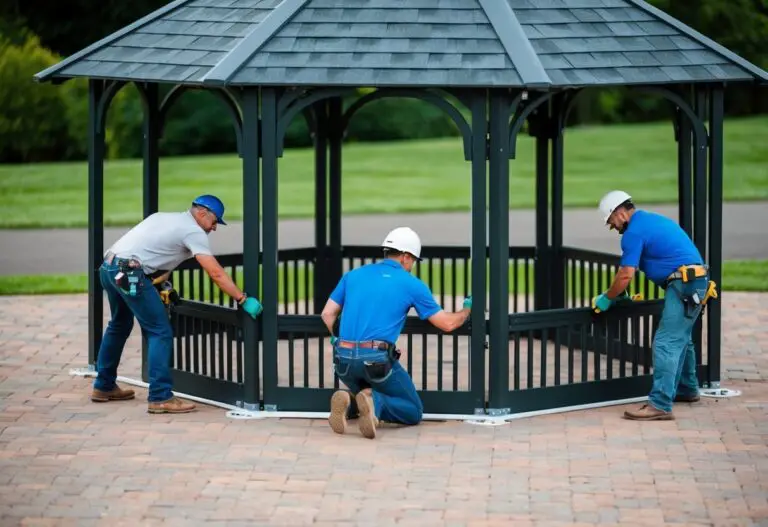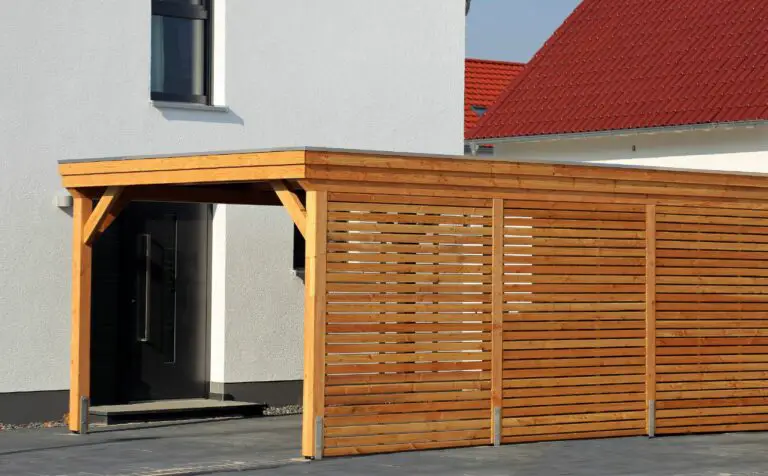When it comes to sheltering your camper from the elements, the proper sizing of a carport is a crucial factor to consider. Campers, with their varying dimensions and unique structural features, often require more space than regular vehicles.
Recreational vehicles (RVs), being road-legal, usually stretch to the limit of 8 feet in width. This necessitates a carport that measures between 16 to 20 feet wide, rather than a basic 12 feet wide.
Furthermore, to ascertain the appropriate length of the carport, you should measure the full length of your RV and add an additional 4 to 8 feet. This extra space ensures you can comfortably park your vehicle without the risk of getting too close to the front wall merely to shut the door.
In this guide, we delve into the critical question – what size carport is ideal for a camper?

Measure the Height, Width, and Length of Your Camper
Measuring your camper is a critical first step to ensure you select the right size carport. Here’s how to measure each dimension:
- Height: Start from the ground and measure up to the highest point of your camper. Don’t forget to include any roof-mounted features such as air conditioners, vent covers or antennas in your measurement, as they add to the overall height.
- Width: Measure the widest point of your camper, which is usually the body, not including the mirrors. This measurement is important to ensure you’ll have enough room to open doors and access compartments.
- Length: Measure from the very front of the camper to the very back, including any additional components such as a rear-mounted spare tire or a tow bar at the front.
Determine the Minimum Size Requirements for Your Camper
Determining the minimum size requirements for a camper involves considering various factors such as its width and length, height, and overhang.
The width and length of the camper will depend on the number of people it can accommodate comfortably and the type of activities that will be done inside. The height of the camper should also be taken into consideration to ensure that it can fit in a carport or garage without any issues.
Width and Length
The width and length of the vehicle in question play a crucial role in determining the appropriate dimensions for a shelter that will provide sufficient protection from weather elements while maintaining ease of access.
When considering the width, it is important to take into account any roof clearance that may be necessary for entry and exit. Corner post placement should also be considered to ensure that they do not interfere with the vehicle’s doors or windows.
The length of the carport should accommodate the entire length of the camper without causing any overhangs, which could increase vulnerability to wind damage.
Height and Overhangs
If the carport is too short, it may not provide enough clearance for the camper’s roof accessories such as air conditioners or antennas. On the other hand, if the structure is too tall, it can increase wind resistance and may be more expensive to build.
The roof pitch should also be taken into account to prevent water from pooling on top of the carport, which can cause damage to both the shelter and the vehicle. Additionally, snow load is another important factor that must be considered when choosing a carport size for a camper in areas with heavy snowfall.
Overhangs can protect vehicles from rain or sun exposure and add extra storage space for camping gear or maintenance equipment. Therefore, it is essential to carefully consider these factors before selecting an appropriate size for a carport that provides adequate protection and functionality for your camper.
Consider Additional Space for Accessories and Maintenance
Consideration of additional space for accessories and maintenance when choosing a carport size for a camper is crucial. The first subtopic to consider is awning space, which will provide protection from the elements while maintaining outdoor living spaces.
Secondly, access for maintenance and repairs should be considered to ensure that essential work can be conducted comfortably and with ease.
- Awning Space
There are various types of awnings available in the market, including retractable, fixed, and portable options. Retractable awnings provide flexibility in terms of usage, while fixed ones offer more stability during harsh weather conditions.
Portable awnings are suitable for campers who prefer versatility and mobility. However, it is essential to consider the pros and cons of each type before making a decision.
Awnings can provide shade from direct sunlight, protect against light rain showers, and create additional living space outside the camper. On the other hand, they may require frequent maintenance due to their exposure to natural elements such as wind and rainwater.
Ultimately, selecting an appropriate size for an awning depends on individual needs and preferences. It should be spacious enough to accommodate outdoor furniture or equipment but not too big that it becomes challenging to set up or store away when not in use.
- Access to Maintenance and Repairs
Design considerations and safety measures are crucial when it comes to choosing the right size for a carport that can accommodate your camper. Apart from the awning space, access for maintenance and repairs should also be taken into account.
Here are some factors you need to consider to ensure optimal access:
- The width of the carport should allow enough space for opening doors and moving around the camper.
- The height clearance must be sufficient enough to accommodate the height of your RV, including any antennas or air conditioning units mounted on top.
- The location of support posts must be strategically placed so they do not obstruct entry or exit points.
- If possible, add a side door or window in your carport design to provide easy access.
Choose the Right Material for Your Carport
Selecting the right material for your camper carport is crucial as it directly impacts the durability, maintenance, and overall cost of the structure. Here are the most common materials used:
- Steel: Steel carports are sturdy and resistant to various weather conditions. They are durable and require less maintenance compared to other materials. However, they can be more expensive and are often heavier, which may require more robust foundations.
- Aluminum: Aluminum carports are lighter and resistant to corrosion. They are also durable but can be susceptible to damage from heavy winds or impacts.
- Wood: Wooden carports can be more aesthetically pleasing and offer more customization options. They are sturdy but require regular maintenance to prevent rot and insect infestations. Depending on the type of wood used, they can also be more costly.
- Polyethylene or PVC: These materials are often used for portable or temporary carports. They are less expensive, lightweight, and resistant to UV rays and water. However, they may not offer the same level of durability and protection as metal or wood carports.
Installation and Maintenance Considerations
To ensure your carport is installed correctly and will last for years, there are several installation and maintenance considerations to keep in mind.
Ventilation options should be considered to prevent moisture build-up and potential damage to your camper. Additionally, weather protection is essential in protecting both the carport and the camper from harsh elements.
Here are some other factors to consider:
- Proper anchoring: A sturdy foundation with proper anchoring is crucial for stability during high winds or storms.
- Maintenance schedule: Regular cleaning and inspection can help prolong the lifespan of your carport.
- Professional installation: Hiring a professional installer can ensure that all components are correctly assembled, minimizing any potential issues down the road.
- Material compatibility: Ensure that the material used for your carport is compatible with your camper’s weight capacity to avoid any structural damages.
- Warranty coverage: Reviewing warranty coverage can give you peace of mind knowing that any issues or defects will be covered within a certain time frame.
The Bottom Line
Choosing the right size carport for your camper is crucial to ensure its protection and longevity. It is essential to measure the height, width, and length of your camper accurately before determining the minimum size requirements for your carport.
Consider additional space for accessories and maintenance to avoid any inconvenience later on.
Choosing the right material for your carport requires careful consideration as it will affect its durability in the long run. Installation and maintenance are vital factors that should not be overlooked.





